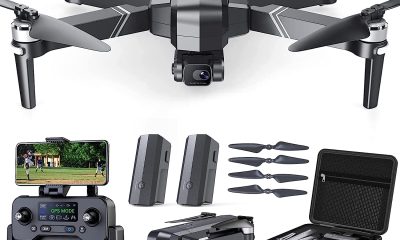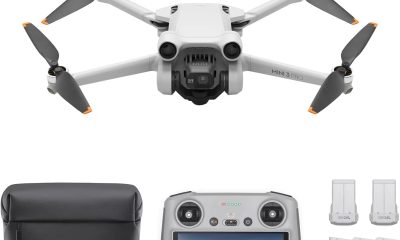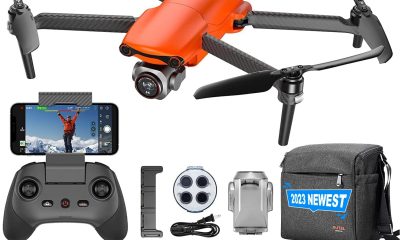Travel
Portable Wi-Fi Hotspots: Stay Connected Anywhere

In today’s interconnected world, staying connected while on the move is no longer a luxury but a necessity. Whether you’re a frequent traveler, a remote worker, or someone who simply values internet access wherever you go, portable Wi-Fi hotspots have become essential tools. This article explores the advantages of Wi-Fi hotspots, how they function, and why they might be the perfect solution for your connectivity needs.
What Exactly Is a Portable Wi-Fi Hotspot?
A portable Wi-Fi hotspot is a compact device that provides internet connectivity by creating a personal network. Essentially, it acts as a mini router, connecting to the internet via a mobile network and allowing multiple devices to access the web through it. These gadgets are typically small enough to fit in your pocket, making them incredibly convenient for on-the-go use.
How Does a Portable Wi-Fi Hotspot Function?
Portable Wi-Fi hotspots work by leveraging cellular networks (3G, 4G LTE, or 5G) to access the internet. Here’s a detailed breakdown of their operation:
- Cellular Connection: The hotspot connects to a mobile network tower through a provider. It uses a SIM card, similar to those in smartphones, to establish an internet connection.
- Data Transmission: The device receives data from the network and transmits it wirelessly through a Wi-Fi network that other devices can connect to.
- Device Connectivity: Various gadgets such as smartphones, laptops, and tablets can connect to this Wi-Fi network, just like they would with a standard Wi-Fi router.
- Battery Life: Most portable hotspots are battery-powered, offering several hours of internet access on a single charge. Some models even include the ability to charge other devices.
Advantages of Portable Wi-Fi Hotspots
- Convenience and Portability: The primary advantage of a Wi-Fi hotspot is its portability. These devices are lightweight and compact, making them easy to carry. They provide internet access in areas where traditional Wi-Fi may not be available, such as remote regions or outdoor settings.
- Reliable Internet Access: Portable hotspots offer a more stable connection compared to public Wi-Fi networks, which can be insecure and unreliable. This is especially important for activities like video calls, online work, or streaming.
- Connectivity for Multiple Devices: Hotspots can connect several devices simultaneously, which is useful when traveling with others or when multiple gadgets need internet access.
- Cost-Effectiveness: Depending on your data plan, using a hotspot can be more economical than purchasing separate SIM cards or data plans for each device. Some mobile providers even offer data plans specifically for hotspots.
- Enhanced Security: Hotspots typically come with encrypted connections, reducing the risk of data breaches and cyber attacks compared to public Wi-Fi networks.
Factors to Consider When Choosing a Wi-Fi Hotspot
- Network Compatibility: Ensure the hotspot supports the network frequencies used by your provider. Some devices support multiple network bands, which can be beneficial for frequent travelers.
- Battery Life: Battery life varies between models. If you need extended usage without frequent recharging, look for hotspots with long battery life or those that offer device charging capabilities.
- Data Plan Options: Check with your service provider about the available data plans. Some providers offer specific plans for hotspots, while others may impose restrictions or slow down speeds after a certain data usage threshold.
- Speed and Performance: Different hotspots offer varying speeds. For tasks like video streaming or file transfers, choose a hotspot that supports the latest network technologies such as 5G.
- Additional Features: Some hotspots come with extra features like built-in USB ports for charging, the option to connect external antennas for better signal reception, or touch screens for easier management.
Tips for Using Portable Wi-Fi Hotspots
- Keep Track of Data Usage: Monitor your data usage to avoid exceeding your plan limits. Many hotspots have built-in tracking tools, or you can check usage through your carrier’s app or website.
- Ensure Security Measures: Use a strong password for your Wi-Fi network and enable encryption (WPA2) in the hotspot settings to protect your data and prevent unauthorized access.
- Manage Battery Life: Extend battery life by turning off the hotspot when not in use and avoiding extreme temperatures. Carry a charger if you expect extended use.
- Update Firmware: Manufacturers occasionally release firmware updates to enhance performance and security. Regularly check for updates to ensure your hotspot functions optimally.
Portable Wi-Fi hotspots are versatile tools that keep you connected in various situations. Their portability, reliability, and ability to connect multiple devices make them invaluable for travelers, remote workers, and anyone needing internet access. By understanding how these devices operate and considering factors like network compatibility, battery life, and data plans, you can select the right portable hotspot to meet your connectivity needs. Whether exploring new destinations or working from unconventional locations, a portable Wi-Fi hotspot ensures you’re always just a connection away from the online world.
Travel
When is it a Good Time to Buy Electronic Equipment?

Electronics tend to be on the pricier side, and making the purchase at the right time can make all the difference in setting the price. Everything from smartphones to laptops, TVs, and game consoles falls into this category. By knowing when items tend to go on sale throughout the year, you can save a significant amount of money. Below are the best times of year to buy electronics:
1. Black Friday and Cyber Monday
Arguably the most popular shopping event of the year, Black Friday, which falls the day after Thanksgiving in the U.S., is famous for offering steep discounts on electronics. Retailers, both in-store and online, slash prices to kick off the holiday shopping season. If you’re in the market for laptops, TVs, smartphones, or smart home devices, this is one of the best times to buy.
Cyber Monday, which is more focused on online sales, often extends the savings further with exclusive web-based deals.
Tip: Know your items in advance, research prices, and then capitalize on them during these sales. Some discounts may be deep, but not all of them are true deals.
2. Back-to-School Season
In July and August, retailers hold back-to-school sales on tech, focusing on laptops, tablets, and accessories like headphones. The sales are perfect for students and parents, though they are not limited to either. Brands like Apple and Microsoft may offer student discounts or bundle deals that include free items, such as wireless headphones.
Tip: Even if you are not a student, pay attention to educational discounts from stores, as they are often available to everyone.
3. Amazon Prime Day
Mark your calendar for mid-July for Amazon’s annual Prime Day, which offers great deals on electronics for Prime members. In recent years, other retailers, like Best Buy and Walmart, have jumped in with competitive sales. From smart home gadgets to Bluetooth speakers and more, Prime Day has become a serious contender to Black Friday.
Tip: Many retailers allow you to start a free trial for Amazon Prime if you don’t want to commit to a full membership, allowing you to take advantage of the deals.
4. Introduction Cycles of New Products
Another great time to buy electronics is during or right before the launch of new products. Major players like Apple, Samsung, and Sony upgrade their products annually, leading to price cuts on older models. For example, new iPhones are announced in September, which makes August a prime time to score deals on the previous year’s model.
Tip: Unless you need the latest technology, last year’s model often performs just as well and comes at a much better price.
5. Holiday Weekend Sales
Major holidays like Labor Day, Memorial Day, and the Fourth of July often bring about sales that many shoppers overlook. Discounts can apply to everything from small kitchen gadgets to larger electronic entertainment systems. Retailers use these holiday weekends to clear out older inventory, which can lead to great deals.
Tip: These sales often feature clearance stock, so if you’re not looking for the latest model, holiday weekends are ideal for finding good discounts.
6. End of the Year Sales
In December, you’ll find electronics clearance sales in full swing as manufacturers try to close out the year strong. After Christmas, and in the week before New Year’s Eve, items that didn’t sell well during the holidays are deeply discounted. This is a good time to look for TVs, home theater systems, and gaming consoles.
Tip: Inventory is limited, so it’s crucial to grab the best deal the moment you find it.
While timing is everything when it comes to buying electronic equipment, knowing the best times of the year to shop will go a long way in helping you save. Whether you’re taking advantage of Black Friday deals, back-to-school season, or tracking new product launch cycles, there are plenty of opportunities to snag great deals. Patience, research, and planning are the keys to making your next tech purchase both smart and affordable.
Travel
Packing Light: Gadgets for the Minimalist

For the modern-day adventurer, traveling light is an art. Efficiency and freedom of movement are essential, and a minimalist traveler seeks to pack only what is necessary without sacrificing convenience. Thanks to recent technological innovations, it’s now possible to pack smart without leaving anything essential behind. Here are gadgets no minimalist traveler should omit for a light, efficient journey.
1. Power Bank Portable Charger
A portable charger is one of the essential items you should never leave behind. Smartphones, tablets, and cameras are integral to capturing moments and staying connected. A lightweight but high-capacity power bank will ensure you never run out of battery during important moments. Look for a slim option that offers multiple charging options, allowing you to share power among your devices without added bulk.
2. International Travel Adapter
A universal travel adapter with interchangeable plugs is a minimalist traveler’s best friend. Instead of carrying several adapters for different regions, this device ensures compatibility almost anywhere in the world. Some versions also come with USB ports, enabling you to charge multiple devices simultaneously, reducing the need for extra chargers.
3. E-Reader or Tablet
Bulky books take up too much space in your luggage. An e-reader or tablet allows you to carry hundreds of books, magazines, and travel guides in one small, lightweight device. For those who like entertainment options, a tablet can double as a movie player, note-taker, and even a work tool for digital nomads—all without the need for a heavier laptop.
4. Wireless Traveling Earbuds
Over-ear headphones may provide better sound quality, but they can be large and cumbersome. Compact wireless earbuds are easy to carry and still offer excellent sound. Noise-canceling features make long flights or noisy environments more tolerable, and all without the bulk of full-sized headphones.
5. Compact Camera or Smartphone Gimbal
If you’re an avid photographer or videographer, consider a compact camera or smartphone gimbal. Minimalist travelers often prefer pocket-sized action cameras or smartphone attachments instead of bulky DSLR cameras. A small gimbal stabilizer allows you to capture smooth video without heavy equipment weighing you down.
6. Folding Water Bottle
Staying hydrated is crucial during travel, but standard water bottles take up valuable space. A collapsible water bottle solves this problem, folding up when empty and freeing up space for other important items. Most are made from flexible silicone, making them both lightweight and easy to pack.
7. Multi-Tool Kit
A small, travel-friendly multi-tool can be a lifesaver during your journey. Whether you’re opening bottles or fixing small items, a lightweight multitool offers numerous functions without adding bulk to your luggage. Many options are TSA-compliant, so you won’t have to worry about airport security.
8. Travel Laundry Kit
Packing light often means doing laundry on the go. A portable travel laundry kit, including a washbag, detergent, and even a travel clothesline, allows you to wash your clothes in your hotel room or hostel. This helps you pack fewer clothes while staying fresh throughout your trip.
9. Smart Baggage Scale
For the minimalist traveler, avoiding excess baggage fees is key. A digital luggage scale helps ensure your bags stay within weight limits, keeping you organized and informed before heading to the airport. These small devices are lightweight and easy to slip into your bag.
Traveling light with the right gadgets offers a streamlined experience without sacrifices. Essentials like portable chargers, multi-tools, and collapsible water bottles provide efficiency and convenience on the road. Pack smart, travel light, and enjoy the freedom that comes with minimalist travel.
Travel
Eco-Friendly Gadgets for the Sustainable Traveler

Being green need not imply being low tech; with the latest green travel gadgets, you can have your cake and eat it too—embrace great new ideas while at the same time lessening your ecological footprint. Herein follow some of the very top eco-friendly travel gadgets that will augment your adventure and stay true to your sustainable objectives.
- Solar-Powered Chargers
A solar-powered charger is a game-changer for the eco-conscious traveler. These chargers harness the power of the sun to recharge your devices, eliminating the need for disposable batteries or electricity from non-renewable sources. Look for compact, foldable designs that are easy to carry and can charge multiple devices simultaneously. With a solar-powered charger, you’ll always have a green energy source at your disposal, whether you’re camping in the wilderness or exploring a remote village.
- Inbuilt Filter Water Bottles
Hydration is key, but single-use plastic bottles are some of the major pollutants. A reusable water bottle with a filter is your answer. Not only will this prevent the generation of plastic waste, but you will also be assured of clean drinking water wherever you might be. A couple of designs boast an advanced filtration system that removes impurities, improves taste, and hence makes this item highly suitable for both urban adventures and outdoor excursions.
- Biodegradable Travel Toiletries
Besides, personal care products are generally wrapped in single-use plastics that contribute to landfill waste. Instead, switch to travel toiletries that are easy on the environment, such as shampoo bars, biodegradable soap, and cotton swabs made from reusable material. Such products are meant to be lightweight and compact, with no harmful chemicals. Also, take along a refillable travel-sized container of your favorite eco-friendly lotion or sunscreen, reducing the need for single-use plastic packaging.
- Energy-Efficient Travel Adapters
While going for international destinations, one always needs to have a travel adapter; however, most of them are energy suckers as not all have the feature to save energy. Opt for energy-efficient travel adapters that minimize power consumption. They have USB ports and hence can charge many devices at one time. Some come with built-in surge protectors, voltage converters, and tend to be much more energy-efficient.
- Eco-Friendly Luggage
Luggage is getting greener; more brands now offer eco-friendly alternatives to materials, such as recycled plastics and organic cotton. Opt for luggage that is made from sustainable resources and is designed to last long. High-quality and durable luggage reduces how often the luggage needs to be replaced, hence avoiding waste. Also, do your research on brands focusing on ethical manufacturing processes and carbon offset projects.
- Collapsible Reusable Utensils
- Plastic cutlery is a potential environmental pollution hazard when combined with eating on the go. The best compact reusable utensil sets are made of bamboo or stainless steel. Generally, these will be supplied with a fork and a knife, a spoon, sometimes added to by a pair of chopsticks, all packed in a travel case. It is easily cleanable and portable and really practical for an eco-friendly alternative in your travels while eating.
- Green Travel Apps
Technology can drive your personal sustainability efforts. Various apps have been developed to support you in finding green hotels, or even finding facilities for recycling. Also included are a plethora of apps sharing knowledge on local practices about sustainability, tips on green travel, further an eco-friendly journey, and bringing travelers and businesses together. 8. Bio-degradable phone covers Most casings are made of plastic and take many, if not hundreds of years to decompose. Phone covers made from plant fibers and natural rubber would be more eco-friendly since they are biodegradable. These cases will also protect your phone and decompose much faster under composting conditions.
Go hands-on with all these devices on your journey and enjoy the fun in adventures while giving a positively big contribution to environmental stewardship. That is what sustainable travel is all about: making conscious choices. With all these innovative gadgets, one can travel smarter, greener, and closer to one’s conscience.
Trending

 Drones1 year ago
Drones1 year agoRuko-F11GIM-Drones-Camera-Batteries

 Drones1 year ago
Drones1 year agoDJI’s tiny drone

 Home1 year ago
Home1 year agoElectroSave Review

 Drones1 year ago
Drones1 year agoAutel Robotics EVO Lite+ Review

 Bug Repellant Gadgets1 year ago
Bug Repellant Gadgets1 year agoSmosquito Review

 Photography & Videography Drones1 year ago
Photography & Videography Drones1 year agoStealth Hawk Pro Drone Review

 Beauty Gadgets1 year ago
Beauty Gadgets1 year agoBright Selfie Review

 Drones1 year ago
Drones1 year agoSwellpro-Fisherman-Fishing-Waterproof-Propellers Review





















